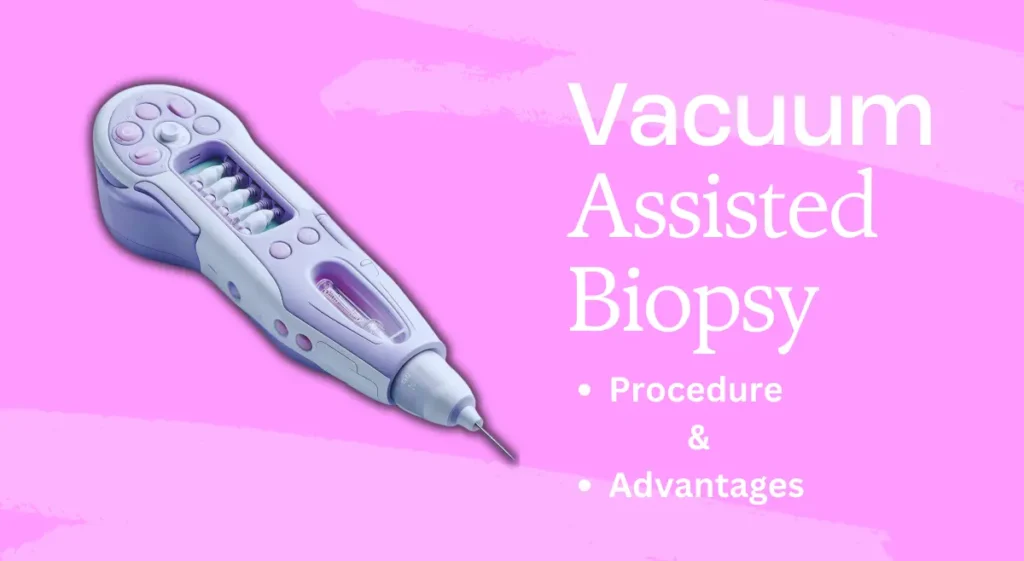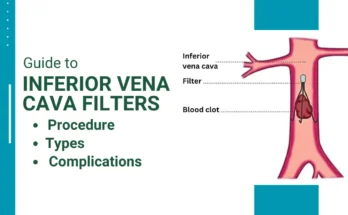
Introduction
In the realm of diagnostic medicine, precision and minimally invasive procedures are the keystones of modern patient care. Vacuum-Assisted Biopsy (VAB) stands at the forefront of this innovative era, offering a less invasive yet highly accurate method for sampling suspicious lesions, particularly in breast tissue. Coupled with the expertise of Interventional Radiology (IR), VAB has transformed the approach to diagnosing and managing breast abnormalities, providing patients with a swift and comfortable experience.
Table of Contents
What is Vacuum-Assisted Biopsy?
Vacuum-Assisted Biopsy is a cutting-edge procedure that utilizes a specialized needle connected to a vacuum device to extract tissue samples from an area of concern within the breast. This technique is particularly advantageous for its ability to obtain larger tissue samples compared to traditional core needle biopsies, enhancing the accuracy of diagnoses while minimizing the need for multiple tissue extractions.
Vacuum-Assisted Biopsy Procedure: A Step-by-Step Guide
Step 1: Patient Preparation Before the procedure, patients are typically advised to avoid taking blood-thinning medications. On the day of the biopsy, the patient will lie down on the examination table, and the area of the breast to be biopsied will be cleaned and sterilized.
Step 2: Local Anesthesia A local anesthetic is administered to numb the area where the biopsy will be performed. This helps ensure the patient’s comfort throughout the procedure.
Step 3: Imaging Guidance Using advanced imaging techniques such as mammography, ultrasound, or MRI, the interventional radiologist identifies the precise location of the abnormal tissue within the breast.
Step 4: Making the Incision A small incision, typically less than a quarter-inch long, is made in the skin to allow the biopsy needle to be inserted.
Step 5: Inserting the Biopsy Needle A hollow biopsy needle is carefully inserted through the incision and directed towards the area of concern, guided by the imaging.
Step 6: Tissue Sample Collection The vacuum-assisted device is activated, which gently pulls the tissue into the needle. Several samples may be collected to ensure an adequate amount for analysis.
Step 7: Placing Biopsy Markers After the tissue samples are collected, a tiny marker may be placed at the biopsy site. This helps in identifying the area in future imaging and follow-up procedures.
Step 8: Closing the Incision The incision is then closed, often with just a bandage, as stitches are usually not necessary.
Step 9: Post-Procedure Care The patient is monitored for a short period for any immediate complications. Instructions are given for at-home care, which typically includes keeping the biopsy area dry and watching for signs of infection.
Step 10: Tissue Analysis The collected tissue samples are sent to a pathology lab, where they are examined under a microscope to determine the presence or absence of cancer cells.
Step 11: Follow-Up Results are usually available within a few days. The patient will have a follow-up appointment to discuss the results and any further treatment if necessary.
Patient Experiences with Vacuum-Assisted Biopsy
Undergoing a medical procedure can be a source of anxiety for many patients. However, the advent of Vacuum-Assisted Biopsy (VAB) has significantly improved patient experiences, particularly in the realm of breast diagnostics. Here’s what patients have reported about their experiences with VAB:
Comfort and Minimal Discomfort Patients often express relief at the minimal discomfort associated with VAB. The procedure is performed under local anesthesia, which means that patients are awake but the area being biopsied is numb. While some patients report a sensation of pressure or a mild pinprick during the administration of the anesthetic, the biopsy itself is generally pain-free1.
Quick Recovery One of the most appreciated aspects of VAB is the quick recovery time. Patients can usually resume normal activities shortly after the procedure. The non-surgical nature of VAB means that there are no stitches, and the small incision requires only a bandage1.
Emotional Relief The accuracy and efficiency of VAB provide emotional relief to patients. Knowing that a comprehensive sample has been taken for analysis can alleviate the stress of waiting for a diagnosis. Additionally, the placement of a tiny marker during the procedure reassures patients that the exact location of the abnormality can be easily identified in future imaging1.
Post-Procedure Experience After the procedure, some patients may experience slight bruising or discomfort at the puncture site, which typically resolves within 24 to 48 hours. Simple over-the-counter pain relief like paracetamol is usually sufficient to manage this. Patients are advised not to take medications containing aspirin as it may increase bruising23.
Overall Satisfaction The feedback from patients who have undergone VAB is overwhelmingly positive. The procedure’s minimally invasive nature, combined with the expertise of interventional radiologists, contributes to a sense of safety and satisfaction among patients. The ability to obtain a precise diagnosis with minimal physical impact is a significant advancement in patient-centered care4.
Technological Advancements in Vacuum-Assisted Biopsy
The field of Vacuum-Assisted Biopsy (VAB) has seen remarkable technological progress, enhancing the precision and efficiency of breast lesion diagnostics. Some of the key advancements include:
Digital Breast Tomosynthesis (DBT) Guidance: The integration of DBT with VAB has significantly improved the procedure’s accuracy. DBT provides a 3D representation of the breast, allowing for better visualization of lesions, particularly microcalcifications1. This has led to shorter procedure times and higher tissue sampling success rates1.
Robotic Systems: The advent of robotic-assisted VAB systems has further refined the procedure. These systems offer greater control and precision, ensuring that the biopsy needle targets the abnormal tissue accurately2.
Stimulated Raman Scattering Microscopy: This innovative imaging technique allows for near real-time histopathological tissue analysis during the procedure, providing immediate feedback on the sampled tissue.
Miniaturized Devices: The development of smaller, battery-powered VAB devices has made the procedure more accessible and less invasive. These devices can be easily maneuvered, reducing patient discomfort and recovery time4.
Statistical Outcomes of Vacuum-Assisted Biopsy
The statistical outcomes of VAB reflect its efficacy and safety as a diagnostic tool:
Malignancy Detection Rates: Studies have shown that VAB is highly effective in detecting malignancies. For instance, the malignancy rates for BI-RADS US category 3, category 4a, and category 4b patients who underwent VAB were found to be 0.6%, 6.4%, and 8.3%, respectively5.
Procedure Success Rates: VAB procedures have high success rates, with some studies reporting success rates of 99.2% to 100% across different biopsy types.
Surgical Upstaging Rates: The surgical upstaging rates for VAB-proven lesions are low, indicating that the procedure is reliable in providing accurate diagnoses without the need for additional surgical intervention.
Recurrence Rates: The recurrence rate of breast masses after VAB is relatively low, with one study reporting a rate of 13.16%, confirmed by follow-up ultrasound.
Case Studies
- Case Study 1: Diagnostic Accuracy of VAB for Indeterminate Breast Microcalcifications A study published in the Egyptian Journal of Radiology and Nuclear Medicine compared the diagnostic accuracy of VAB and Core Needle Biopsy (CNB) in the diagnosis of indeterminate breast microcalcifications1. The study included 268 lesions, with 136 undergoing VAB and 132 CNB. The results showed that VAB had a higher diagnostic accuracy (97%) compared to CNB (84.8%). Moreover, the re-operation rate was lower in the VAB group (2.9%) than in the CNB group (7.5%), indicating that VAB is a superior diagnostic tool for indeterminate breast microcalcifications and can reduce patient morbidity1.
- Case Study 2: VAB in Close Proximity to the Skin A case reported in the Journal of Medical Case Reports discussed the use of VAB for a lesion located approximately 5 mm from the skin2. The lesion consisted of widely spread microcalcifications and was isoechoic on ultrasound examination. The VAB probe was inserted antidiametrically into the breast, and although only a small proportion of the microcalcifications were excised initially, the probe tip underlying the skin could be palpated. This allowed for the localization and subsequent total excision of the suspicious microcalcifications under local anesthesia2. This case illustrates the potential of VAB as an alternative approach to localize and biopsy superficial lesions.
Comparison of Vacuum-Assisted Biopsy with Other Biopsy Methods
Vacuum-Assisted Biopsy (VAB) has become a preferred method for breast lesion sampling, but how does it stack up against other biopsy methods? Let’s compare VAB with Core Needle Biopsy (CNB) and Fine Needle Aspiration (FNA):
Vacuum-Assisted Biopsy (VAB) vs. Core Needle Biopsy (CNB)
- Sample Size: VAB typically retrieves larger samples than CNB, which can lead to a more accurate diagnosis and reduces the need for repeat procedures1.
- Diagnostic Accuracy: VAB has been shown to have a lower rate of underestimating conditions like ductal carcinoma in situ (DCIS) compared to CNB1.
- Procedure Time: VAB can collect multiple samples through a single insertion, potentially reducing the procedure time compared to multiple insertions with CNB2.
- Complications: CNB has a slightly lower complication rate compared to VAB, which may be a consideration for some patients1.
Vacuum-Assisted Biopsy (VAB) vs. Fine Needle Aspiration (FNA)
- Cell vs. Tissue: FNA extracts cells, while VAB removes tissue samples, providing more context for pathological analysis.
- Accuracy: VAB is generally more accurate than FNA because it provides a larger, more representative sample of the suspicious area.
- Indications: FNA is often used for palpable masses and initial assessments, while VAB is preferred for non-palpable lesions and microcalcifications.
Vacuum-Assisted Biopsy (VAB) vs. Open Surgical Biopsy (OSB)
- Invasiveness: VAB is less invasive than OSB, leading to quicker recovery and less scarring.
- Anesthesia: VAB is performed under local anesthesia, whereas OSB typically requires general anesthesia.
- Cost and Convenience: VAB is less costly than OSB and can be performed in an outpatient setting, making it more convenient for patients.
In conclusion, VAB offers a minimally invasive, accurate, and efficient alternative to traditional biopsy methods. Its ability to obtain larger samples through a single insertion and under image guidance makes it a valuable tool in the diagnosis and management of breast lesions.
Insurance and Cost Considerations for Vacuum-Assisted Biopsy
- Understanding Insurance Coverage Most health insurance plans cover biopsy procedures, including VAB, especially when deemed medically necessary. However, coverage can vary based on the insurance provider, the specific health plan, and the region. Patients should consult with their insurance company to understand the specifics of their coverage, including deductibles, copayments, and any potential out-of-pocket expenses.
- Cost-Effectiveness of VAB VAB is often more cost-effective than traditional surgical biopsies. A study found that the mean procedure costs for VAB were almost 30% less than that of surgical revision for the removal of benign lesions1. This is due to the minimally invasive nature of VAB, which typically requires less recovery time and fewer resources.
- Direct and Indirect Costs The total cost of VAB includes direct medical costs such as the procedure itself, the use of the facility, and any necessary imaging. Indirect costs may involve lost wages due to time off work, travel expenses, and childcare. It’s important for patients to consider both types of costs when planning for the procedure.
- Cost-Minimization Analysis A cost-minimization analysis between VAB and lumpectomy showed that VAB could be a more economical option. From a hospital’s perspective, the average total cost for a patient undergoing VAB was lower compared to a lumpectomy, resulting in average savings2. This analysis highlights the potential financial benefits of choosing VAB over more invasive procedures.
- Negotiating with Healthcare Providers Patients may have the option to negotiate the cost of their procedure, especially if they are uninsured or if their insurance covers only a portion of the cost. Many hospitals and clinics are willing to discuss payment plans or reduced rates for services.
- Financial Assistance Programs For those who may struggle with the costs, financial assistance programs are available. These programs can help cover the full or partial cost of the procedure for eligible patients. Information about such programs can usually be found through hospitals, clinics, or non-profit organizations.
The Role of Interventional Radiology in VAB
Interventional Radiology plays a pivotal role in the VAB process. IR specialists employ advanced imaging techniques such as mammography, ultrasound, or MRI to guide the biopsy needle with pinpoint accuracy. This image-guided approach ensures that the area of abnormality is precisely targeted, thereby maximizing diagnostic yield and reducing the risk of complications.
Benefits of Vacuum-Assisted Biopsy
The benefits of VAB are manifold. Patients experience less discomfort and quicker recovery times compared to surgical biopsies. The procedure is typically performed under local anesthesia as an outpatient service, allowing individuals to resume their daily activities with minimal interruption. Moreover, VAB’s enhanced precision reduces the likelihood of repeat procedures, providing peace of mind and convenience for patients.
Conclusion
Vacuum-Assisted Biopsy, augmented by the expertise of Interventional Radiology, represents a significant leap forward in the early detection and treatment of breast cancer. As a testament to the advancements in medical technology, VAB stands as a beacon of hope for patients, offering a less invasive, more accurate, and patient-friendly diagnostic option.
Frequently Asked Questions about "vacuum-assisted biopsy"
- Vacuum-assisted biopsy is a minimally invasive procedure used to obtain tissue samples from the body for diagnostic purposes. It involves using a vacuum-powered device to collect multiple tissue samples through a single insertion.
- During a vacuum-assisted biopsy, a specialized needle with a vacuum system is inserted into the target tissue under imaging guidance. Once in position, the vacuum is activated, allowing the needle to collect tissue samples as it is advanced and rotated within the lesion.
- Vacuum-assisted biopsy offers several advantages over traditional biopsy methods, including the ability to obtain larger tissue samples, increased accuracy, fewer needle insertions, reduced procedure time, and less post-procedure discomfort.
- Vacuum-assisted biopsy can be used to biopsy a wide range of lesions, including breast masses, thyroid nodules, soft tissue tumors, and lesions in the liver, kidney, and lung.
- Vacuum-assisted biopsy is typically well-tolerated by patients and is performed under local anesthesia to minimize discomfort. Some patients may experience mild pressure or discomfort during the procedure, but it is generally considered to be less painful than traditional surgical biopsy.
- The duration of a vacuum-assisted biopsy procedure varies depending on the size and location of the lesion being biopsied. In general, the procedure can take anywhere from 30 minutes to an hour to complete.
- While vacuum-assisted biopsy is considered safe, there are some risks associated with the procedure, including bleeding, infection, and damage to surrounding structures. However, these risks are rare and are typically outweighed by the benefits of obtaining an accurate diagnosis.
- The turnaround time for vacuum-assisted biopsy results varies depending on the laboratory where the tissue samples are sent for analysis. In general, results are typically available within a few days to a week after the biopsy procedure.
- Yes, vacuum-assisted biopsy is commonly used for the diagnosis of cancer. It allows for the collection of larger tissue samples, which can provide more accurate information about the nature of the lesion and help guide treatment decisions.
- While vacuum-assisted biopsy is highly effective for many types of lesions, there are some limitations to its use. For example, it may not be suitable for lesions located in certain anatomical areas or those that are very small or difficult to access. Additionally, some lesions may require additional imaging guidance or surgical biopsy for adequate sampling.



